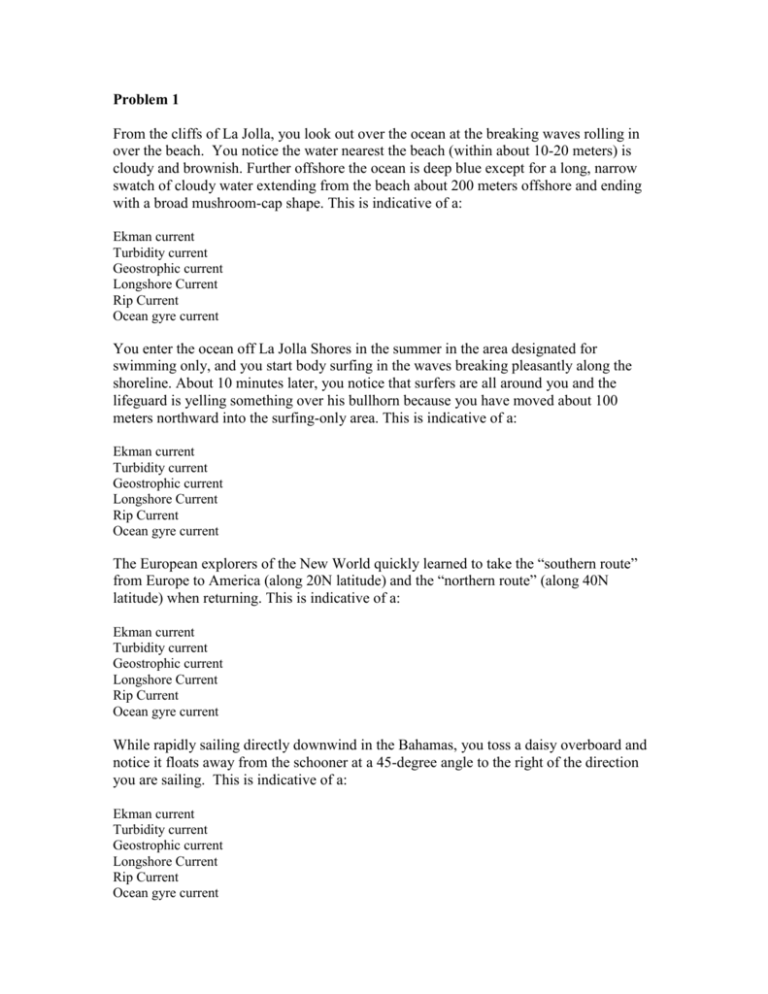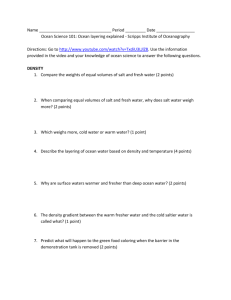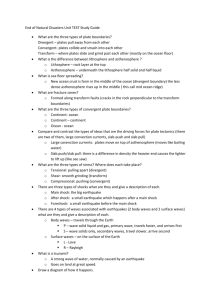Problem 1:
advertisement

Problem 1 From the cliffs of La Jolla, you look out over the ocean at the breaking waves rolling in over the beach. You notice the water nearest the beach (within about 10-20 meters) is cloudy and brownish. Further offshore the ocean is deep blue except for a long, narrow swatch of cloudy water extending from the beach about 200 meters offshore and ending with a broad mushroom-cap shape. This is indicative of a: Ekman current Turbidity current Geostrophic current Longshore Current Rip Current Ocean gyre current You enter the ocean off La Jolla Shores in the summer in the area designated for swimming only, and you start body surfing in the waves breaking pleasantly along the shoreline. About 10 minutes later, you notice that surfers are all around you and the lifeguard is yelling something over his bullhorn because you have moved about 100 meters northward into the surfing-only area. This is indicative of a: Ekman current Turbidity current Geostrophic current Longshore Current Rip Current Ocean gyre current The European explorers of the New World quickly learned to take the “southern route” from Europe to America (along 20N latitude) and the “northern route” (along 40N latitude) when returning. This is indicative of a: Ekman current Turbidity current Geostrophic current Longshore Current Rip Current Ocean gyre current While rapidly sailing directly downwind in the Bahamas, you toss a daisy overboard and notice it floats away from the schooner at a 45-degree angle to the right of the direction you are sailing. This is indicative of a: Ekman current Turbidity current Geostrophic current Longshore Current Rip Current Ocean gyre current Problem 2 On a hot sunny day in July, you arrive at Swami’s Beach in Encinitas and find gentle waves and VERY CHILLY water when you dash into the sea. You notice the wind is blowing pretty strongly. You immediately recognize this VERY CHILLY water is due to: Global “dimming” Cold wind blowing from the Arctic latitudes Thermohaline circulation Streamflow runoff from snow-fed mountain streams Upwelling by Ekman transport Ocean gyre circulation Mixing of deep thermocline waters by wave breaking Can you immediately guess the direction of the wind? From ocean to land (westerly wind) From land to ocean (easterly wind) From north to south (northerly wind) From south to north (southerly wind) As the afternoon passes and the sun starts to set, the wind stops blowing strongly. From what direction would you expect the light breeze that kicks up a couple hours after the sun goes down to come from? From ocean to land (westerly breeze) From land to ocean (easterly breeze) From north to south (northerly breeze) From south to north (southerly breeze) What would that breeze be called? (two word answer) Problem 3 Shown is a time series of tropical Pacific sea-surface temperature (SST) in the Nino-3 region (see lower figure). Major El Nino events are often designated by those years that have SST anomalies greater than 2 deg C in the Nino-3 region. List the years of the major El Ninos. (These “years” are usually associated with peak warming during boreal “winters” like Dec 1920 - Feb 1921 => El Nino of ’20-’21) Are there are any major La Nina events by this definition? (SST < -2 deg C) Pourquoi? Nino-3 area is the BOX in the eastern tropical Pacific. Problem 4 Sketched below is the conceptual model of the “Great Ocean Conveyor Belt”. This pattern of ocean circulation is predominantly forced by: Global Winds Raining and evaporating Cooling and heating Geothermal heating, hydrothermal vents, and seep-sea volcanism Ocean bathymetric features Another name for this type of ocean circulation is ______________ (one word answer). If this circulation slowed down, as some have suggested might occur under global warming conditions, the weather over Europe might get (warmer or colder). Problem 5 The hole in this figure is an example of a _______________. The steep rocky bluff would be termed a _______________. This is an example of a ________________. This is an example of a _________________. Problem 6 From a liter of seawater with salinity 17 %o (parts per thousand), you determine from chemical titration that it has 0.2 grams of Calcium and 1 mg of Manganese. What amounts of Calcium and Manganese would you expect to find in seawater with salinity 34%o ? What is the most abundant element (by mass) in seawater? Where does ocean salinity tend to be the highest? In deeper waters Near river mouths At “desert” latitudes Near the equator Near the poles Problem 7 What is Surf? Capillary waves generated by light winds. Fully-developed waves generated by strong winds. Waves that grow larger the farther they travel. Waves moving out of the generating area. Waves moving into shallow water and eventually breaking. What is Swell? Capillary waves generated by light winds. Fully-developed waves generated by strong winds. Waves that grow larger the farther they travel. Waves moving out of the generating area. Waves moving into shallow water and eventually breaking. What is the motion of water particles as ocean waves pass by in the open ocean? They oscillate in circles. They oscillate in ovals. They ride on wave crests. They vibrate in a direction parallel to wave motion. They vibrate in a direction perpendicular to wave motion. At what depth do waves begin to "feel" the bottom? 1 wave height 1 wavelength 1/2 wavelength 10 meters 20 meters What kind of waves to surfers like? Capillary waves Collapsing breakers Plunging breakers Spilling breakers Surging breakers Answers: 1: rip; longshore; ocean gyre (which is geostrophic, but not the unique answer); Ekman 2: upwelling; north to south; land to ocean; land breeze 3: ’72-’73, ’82-’83, ’97-’98 are major El Ninos; except for possibly ’55-’56 there are no major La Ninas by this definition – the reasons for this asymmetry is a current topic of research 4: cooling and heating; thermohaline; colder 5: sea arch; sea cliff; sea stack; sea cave 6: 0.4 grams of Calcium and 2 mg of Manganese (principle of constant proportions); oxygen; At “desert” latitudes 7: Waves moving into shallow water and eventually breaking. Waves moving out of the generating area. They oscillate in circles 1/2 wavelength Plunging breakers








